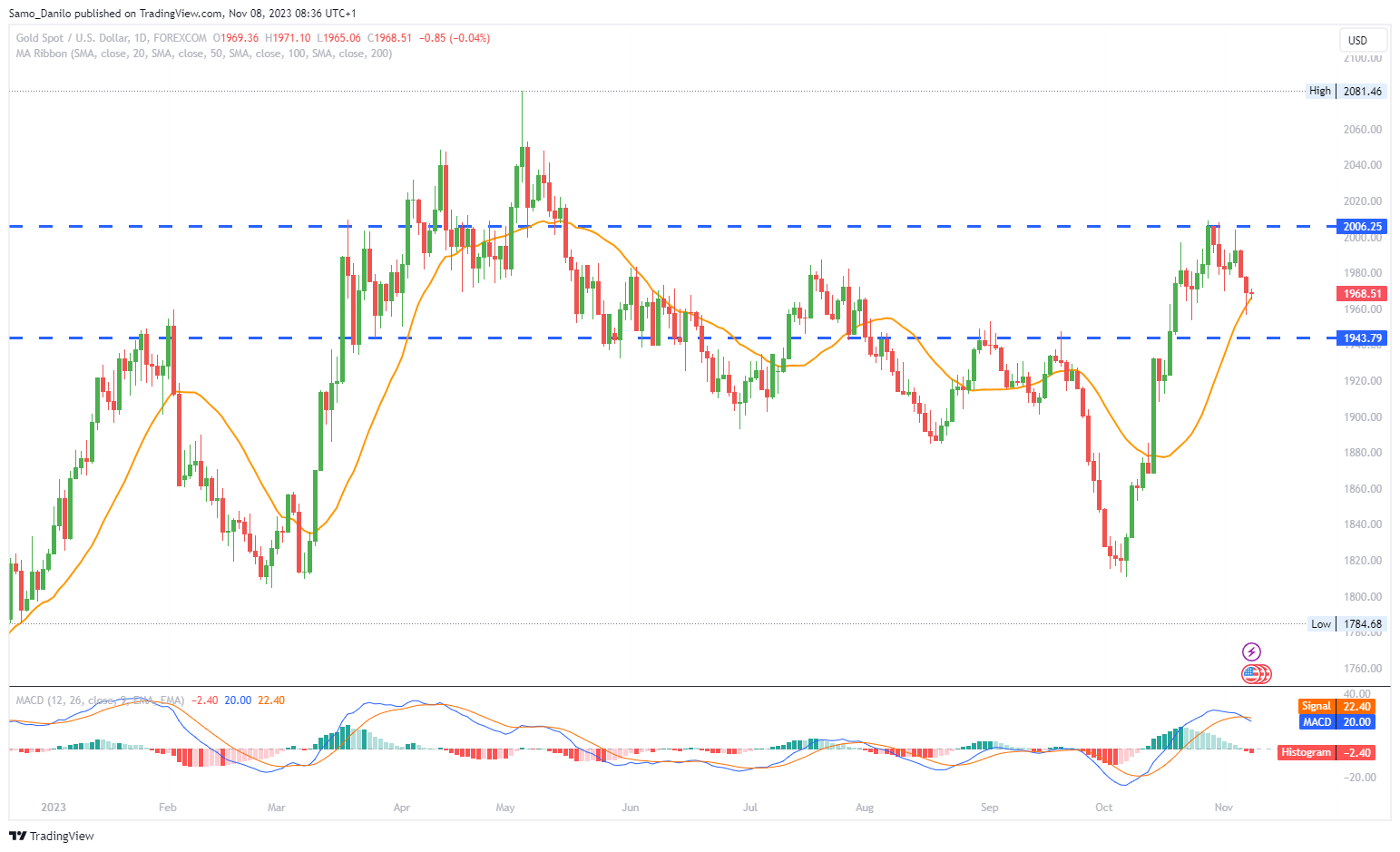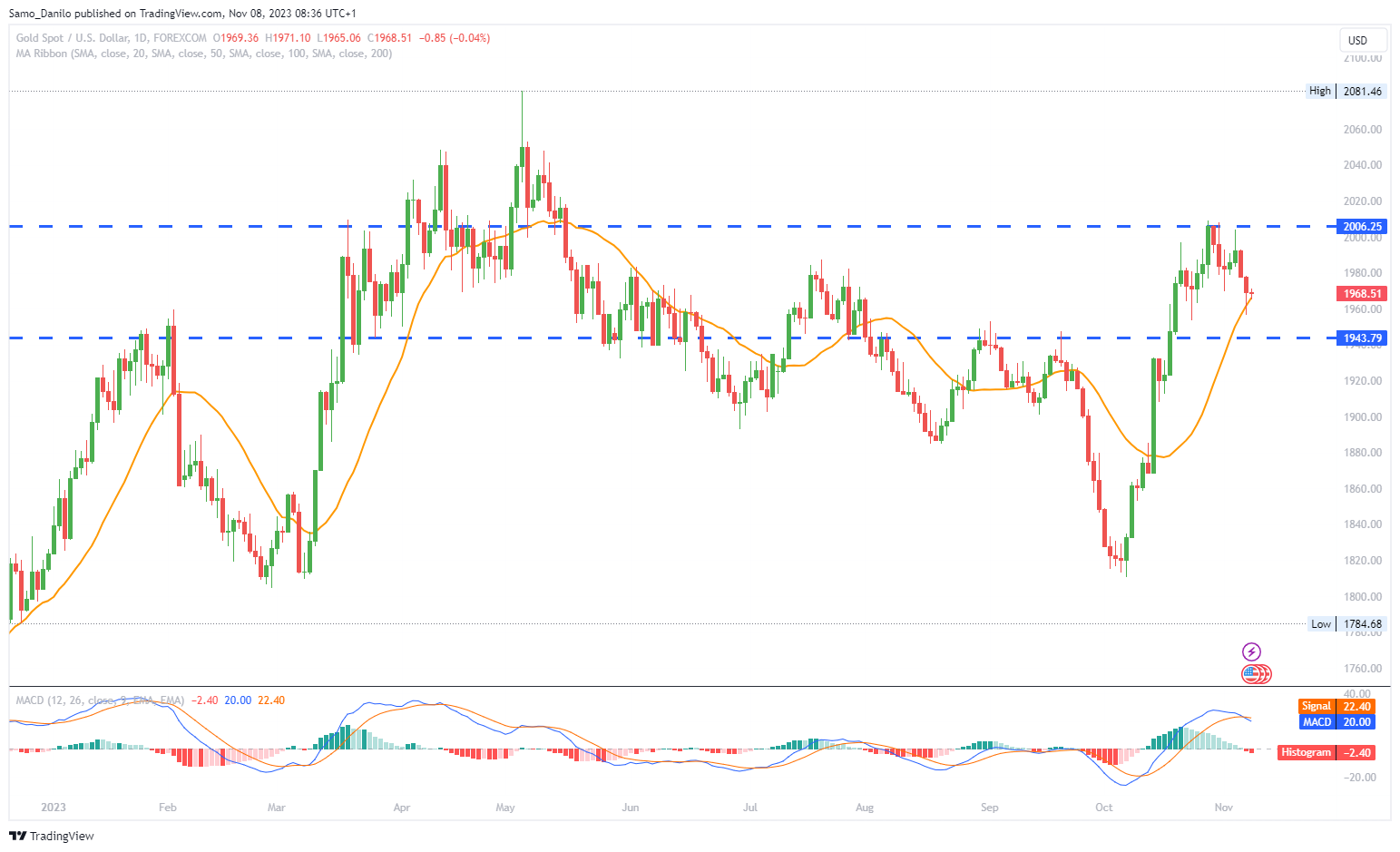EURUSD
- The EUR/USD pair is currently lacking a strong intraday direction and is trading within a narrow range, specifically around the 1.0690 level, during the Asian trading session.
- Despite the recent pullback in US Treasury bond yields and a continued rally in US equity markets, the safe-haven US Dollar (USD) is not strengthening as expected. This is a deviation from the usual inverse correlation between the dollar and risk assets.
- The US Dollar's downside is somewhat cushioned by the prevailing uncertainty regarding the Federal Reserve's (Fed) future path for interest rate hikes.
- Traders are cautious as they await signals from Fed Chair Jerome Powell, who is scheduled to deliver a speech during the early North American session.
- Furthermore, there is an expectation that additional rate hikes by the European Central Bank (ECB) might not be on the table, which suggests a bearish bias for the EUR/USD pair.
Closing statement: In summary, the EUR/USD pair is currently experiencing limited movement and is influenced by factors like US Treasury bond yields, equity markets, and uncertainty regarding future Fed rate hikes. The expectation of a dovish stance from the ECB also adds to the downside pressure on the euro.
GBPUSD
- GBP/USD is currently facing renewed bearish pressure and is trading below the 1.2300 level during European trading on Wednesday.
- After reaching its highest level since mid-September at 1.2428 on Monday and touching the 200-day moving average, GBP/USD reversed its direction and closed with losses.
- Traders are showing reluctance to make aggressive bets and are opting to remain on the sidelines. This cautious approach is likely due to scheduled speeches by the Bank of England (BoE) Governor Andrew Bailey and Federal Reserve (Fed) Chair Jerome Powell.
- Given the significant risk of the UK economy entering a recession, Bailey's remarks will be closely watched to confirm expectations of a rate cut in August 2024.
- The BoE's Chief Economist Huw Pill mentioned that the central bank might not cut rates from their current 15-year high until the middle of next year, which is putting downward pressure on the British Pound (GBP).
| SMA (20) | Slightly Rising |
| |
| RSI (14) | Slightly Falling |
| |
| MACD (12, 26, 9) | Rising |
|
|
Closing statement: In summary, GBP/USD is currently experiencing bearish pressure due to concerns about the UK economy's outlook, potential rate cuts, and caution among traders awaiting key speeches by central bank officials.
GOLD
- Gold price is currently consolidating the losses it has incurred earlier in the week. The precious metal is struggling to find a clear direction as the United States Dollar (USD) is experiencing conflicting commentary from the US Federal Reserve (Fed).
- The uncertain outlook for the Federal Reserve's interest rates is creating a sense of nervousness among investors, particularly after receiving mixed messages from Fed policymakers.
- Different Fed officials have expressed varying opinions on monetary policy. Chicago Fed President Austan Goolsbee highlighted that the central bank's focus might shift towards the duration of keeping rates at their current levels.
- On the other hand, Minneapolis Fed Bank President Neel Kashkari had a slightly hawkish stance, suggesting that the Fed might need to take further action to control inflation. Fed Governor Michelle Bowman hinted at the likelihood of additional rate hikes.
- Fed Governor Christopher Waller emphasized that the exceptional third-quarter US economic growth performance should be closely monitored as the Fed considers its next policy steps. This suggests that robust economic data might influence the Fed's monetary policy decisions.
| SMA (20) | Rising |
|
|
| RSI (14) | Falling |
|
|
| MACD (12, 26, 9) | Slightly Falling |
|
Closing statement:In summary, gold price is currently facing uncertainty as conflicting comments from various Fed officials make it challenging for traders to predict the future of interest rates. Strong US economic data also adds to the complexity of the situation.
CRUDE OIL
- Western Texas Intermediate (WTI) crude oil is rebounding from a more than three-month low, hovering around $77.20 per barrel during the Asian trading hours on Wednesday. This recovery is driven by the US Dollar's attempt to regain some of the losses it experienced in the previous week.
- The American Petroleum Institute (API) reported a significant increase of nearly 12 million barrels in US crude oil stocks last week. Additionally, the Energy Information Administration (EIA) revealed a decrease in crude oil production in the United States for this year, though it's slightly less than previously projected. This change is accompanied by a decline in demand.
- The EIA announced a delay in the release of weekly inventory data until the following week. The agency now expects a 300,000 barrels per day reduction in total petroleum consumption in the US for this year, reversing its prior forecast of a 100,000 barrels per day increase.
- Organization of Petroleum Exporting Countries (OPEC) crude exports have risen by approximately 1 million barrels per day since reaching their low point in August. This increase in exports is driven by seasonally lower domestic demand in the Middle East.
- Crude oil prices are facing headwinds due to mixed economic data from China, the world's second-largest consumer of oil. Although there was strong growth in oil imports in October, signaling a positive trend, the simultaneous contraction in total exports of goods and services exceeded expectations. This has raised concerns about a potential decline in global energy demand.
| SMA (20) | Falling |
|
|
| RSI (14) | Falling |
|
|
| MACD (12, 26, 9) | Falling |
|
|
Closing statement:crude oil is experiencing a rebound from recent lows, but there are concerns due to increased US crude oil stocks, changes in production and consumption forecasts, and mixed economic data from China. These factors contribute to the volatility and uncertainty in the crude oil market.
DAX
- German industrial production figures for September showed a decline of 1.4%, following a 0.1% drop in August. This significant fall in production is attributed to a lackluster demand environment, influenced by challenging macroeconomic conditions.
- Eurozone producer prices displayed a consistent year-over-year downward trend. However, the trends differed among sectors, with prices increasing for capital goods and durable and non-durable consumer goods.
- Corporate earnings played a pivotal role in influencing investor sentiment. Daimler Truck Holding's disappointing Q3 earnings had a negative impact on the auto sector. In contrast, Deutsche Boerse delivered impressive forecasts, helping to counter the automotive sector's woes.
- Corporate earnings played a pivotal role in influencing investor sentiment. Daimler Truck Holding's disappointing Q3 earnings had a negative impact on the auto sector. In contrast, Deutsche Boerse delivered impressive forecasts, helping to counter the automotive sector's woes.
- Market participants are now awaiting the release of the final German Consumer Price Index (CPI) and Eurozone Retail Sales data for potential market impetus. Softer inflation numbers could alleviate pressure on the European Central Bank (ECB) to maintain higher interest rates for an extended period. A larger-than-expected fall in retail sales might impact consumer sector-listed stocks.
| SMA (20) | Falling |
|
|
| RSI (14) | Neutral | ||
| MACD (12, 26, 9) | Slightly Rising |
|
Closing statement: In summary, the DAX faced challenges due to a decline in industrial production, ongoing downward trends in producer prices, and mixed results from corporate earnings. Upcoming economic data and Federal Reserve Chair Jerome Powell's speech could provide further direction to the market.



